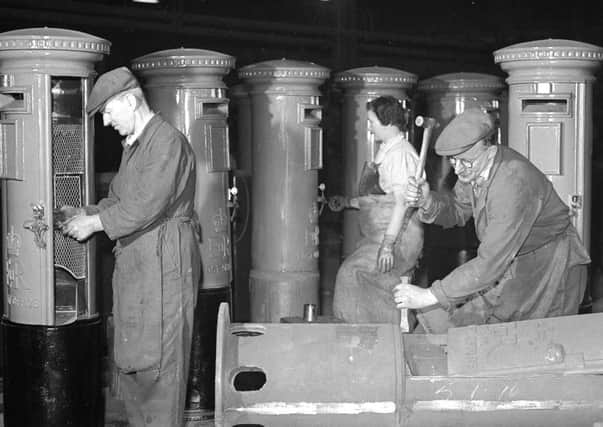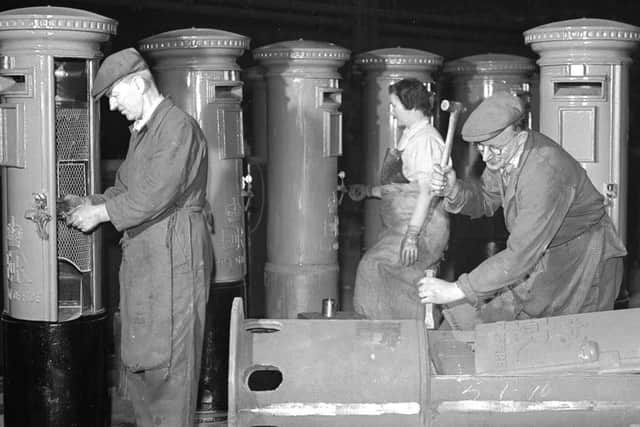IN PICTURES: The historic Carron Works


The Carron Company formed in 1759, known at the time as Roebucks, Garbett and Cadells, to make iron on the north bank of the River Carron on Sir Michael Bruce’s Stenhouse Estate.
From our archives we have produced a pictures slideshow showing workers form down the years manufacturing the products the famous company produced.
Advertisement
Hide AdAdvertisement
Hide AdBelow is a timeline of the Carron Company’s existence from the Falkirk Local History Society.


CARRON COMPANY HISTORY
Anything that could be made in iron was cast, but perhaps the main objective was to begin the lucrative business of making cannon.
By 1765, a contract had been obtained to supply guns to the British Navy, but by 1773, because the guns were of bad quality, this contract was lost and guns of Carron manufacture were withdrawn from all ships of the Navy. That same year, the company, now known as “the Carron Company”, was granted it’s Royal Charter which allowed it to operate on almost modern day lines as a limited liability company.
By this time the control of the company was in the hands of Charles Gascoigne, the son-in-law of Garbett. A ruthless and determined character, he drove the company forward ensuring that the problems were overcome and that Carron was on a sound financial footing. However he left for Russia in 1786 to set up iron manufacturing for the Csarina Catherine the Great and did not return.


Advertisement
Hide AdAdvertisement
Hide AdMany famous people were associated with the works, which at times must have seemed like a never ending experiment. There was John Smeaton, ‘father’ of civil engineering, builder of the first stone Eddystone lighthouse and designer of the Forth and Clyde Canal. He was consulted on any engineering problem faced at the works and designed many machines for use there. Henry Cort also came here to experiment with a method for mass producing malleable iron which eventually, at another works became the ‘puddling process’.
The American inventor, Benjamin Franklin visited the works and is said to have left a design for a stove- ‘Dr Franklin’s stove or the Philadelphia stove’. Another notable name at Carron was that of William Symington who had the engines for the Experiment and the Charlotte Dundas, made there. Designs for firebacks and balustrades were by courtesy of the Adam and Haworth brothers.
After much hard work, a re-appraisal of manufacturing methods and an improvement in the quality and types of iron made, cannons known as “the new light constructed guns”, were made from 1776 and were a success, being sold here and abroad, but they were still refused by the British Government.
It was two years later in 1778 that a completely new type of gun made its appearance at Carron; it was shorter than the cannon and had a much larger bore and was to be called the ‘Carronade’. This gun was soon in demand for use on private ships and was eventually accepted as suitable for use by the British Navy.
Advertisement
Hide AdAdvertisement
Hide AdThey came into their own at a time when opposing ships engaged each other in battle at close quarters, one drawback being their limited range. Many changes would take place in the development of this gun between then and 1800. With the success of the Carronade, the fame of Carron Company spread and also led to the making of a new type of cannon at the works from 1796; the “Blomefield” gun or “Government Pattern” gun.
On Sunday the 26th of August 1787, Robert Burns came to the works but, because it was a Sunday and he didn’t have the necessary “ticket”, he was refused admittance. Along with his friend Willie Nicol, he retired to the Carron Inn opposite the works and had breakfast. He took his revenge by scoring a verse of poetry on a window of the Inn.
At that time the manager and later a partner of Carron Company, was an Englishman called Joseph Stainton. For many years, the works would be in the hands of the Staintons and their relatives, the Dawsons. Under their direction, the company thrived, but it was not until the death of Joseph’s brother Henry in 1851, that it was discovered that the accounts books had been systematically “cooked “ for years.
After lengthy litigations, Henry’s family had to pay back to the company, and hence the shareholders, a vast sum of money. However, it was William Dawson who first suggested a modernisation programme at Carron. New furnaces were built in 1870 and between 1875 and 1883, old buildings were torn down and new ones appeared. The whole area of the works was increased which necessitated in the road to Stenhousemuir being diverted for the umpteenth time since 1760.
Advertisement
Hide AdAdvertisement
Hide AdThe new works were laid out in an integrated fashion and an office block with warehouses was erected on the Stenhouse road. Standing in the middle of this block like a sentinel, the clocktower. One acknowledgment to the past at Carron, was the inclusion in the walls of the tower, of a lintel of the first blast furnace and part of a cylinder cast at the works in 1766 for James Watt, who had worked under the auspices of Dr Roebuck, whilst developing his improved steam engine.
In the early years of the twentieth century, Carron Company held it’s own against competition from all over the British Isles and beyond, the main product, with the exception of pig-iron was the cast iron Carron bath, first introduced in 1866. During both world wars, the company turned to the production of munitions and, at the end of the 2nd World War, Carron Company was ready to meet the demands of peace time reconstruction in the building industry, supplying a large range of domestic products including fire grates, gas and electric cookers and baths.
For many years, large cooking ranges were made for ship’s galleys and the kitchens of prestigious institutions. They had even made iron tiles for the roof of the Houses of Parliament. Back in 1962, the biggest contract ever awarded to a Scottish Ironfoundry came Carron’s way. It was for the production of cast iron rings made in segments, for the Jarrow-Howden tunnel under the River Tyne. Expertise had been gained in this field in the previous three years when the same product had been supplied for the Whiteinch tunnel under the River Clyde.
At that time the production line featured castings for the General Post Office, the Admiralty and Volvo Cars. Other new directions were taken including the production of stainless steel and plastic goods. Carron Company, which once had it’s own coalmines, a fleet of ships carrying goods and passengers, agencies worldwide, showrooms in major cities, a railway system (an early form had been in use from 1760) and ownership of most of the land in the vicinity, suddenly went into receivership in 1982.
Advertisement
Hide AdAdvertisement
Hide AdAfter a series of management buy-outs, production resumed at the works under several individual companies such as, Carron Phoenix, Carron Steelyne and Carron Bathrooms, all carrying on the tradition of first class workmanship and quality of finish, benchmarks laid down by their predecessor many years before. All that remains of the old Carron Company, apart from some buildings erected this century, is the clocktower with it’s embrasure containing a display of Carron guns. Two ancillary works nearby, Mungal Foundry and Engineering Department, both built at the turn of the 20th century, were also demolished.
The once famous Carron dams, which always contained a reserve supply of water, have long since returned to nature.
To see more of Falkirk’s rich heritage visit www.falkirklocalhistorysociety.co.uk